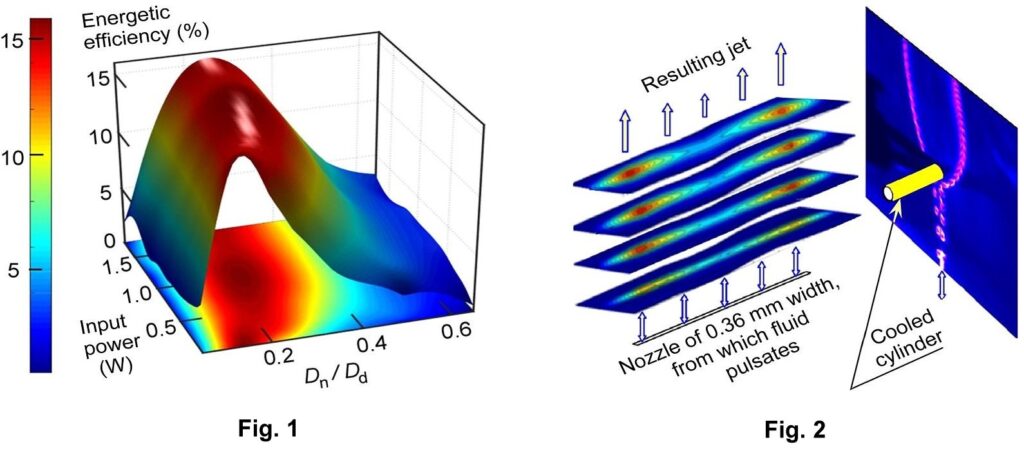Laboratory of Heat and Mass Transfer
|
Department: Department D 2 - Thermodynamics Head: doc. Ing. Zdeněk Trávníček, CSc. |
|
The laboratory encompasses expertise in heat and mass transfer, fluid dynamics and fluidics. Specific missions include passive and active control of flow and temperature fields, intensification of heat and mass transfer in forced convection (e.g. impinging and synthetic jets, wakes). The laboratory is a trendsetter of modern and effective trends in the subject field, which are based on biomimetic principles: known and well-tried concepts of biological systems in nature are applied in technology to enhance human products. |
doc. Ing. Zdeněk Trávníček, CSc.
Ing. Zuzana Antošová (Broučková), Ph.D.
doc. Ing. Alexander I. Fedortchenko, DrSc.
Ing. Jozef Kordík, Ph.D.
Representative research fields and results
Synthetic jets
A synthetic jet is a fluid flow generated from a periodic fluid motion. It is created (synthesized) from the individual "fluid puffs" emitting out of the actuator orifice or a nozzle. The flow in the orifice reverses sign in each period and the time-mean mass flux in the nozzle is zero. Another common expression, zero-net-mass-flux jet, follows from this fact.
The synthetic jets have many perspective applications in active control of flowfields and thermal fields (e.g. in external and internal aerodynamics, cooling electronic components and turbine blades, mixing in chemical reactors, etc.). Many advantageous applications are proposed at microscale, in microelectromechanical systems (MEMS). The basic advantage is simplicity – no blower and no fluid supply piping is required. As a result, the synthetic jets are recently subject of intensive investigations. In the Czech Republic, the investigation started at the beginning of the 21st century.
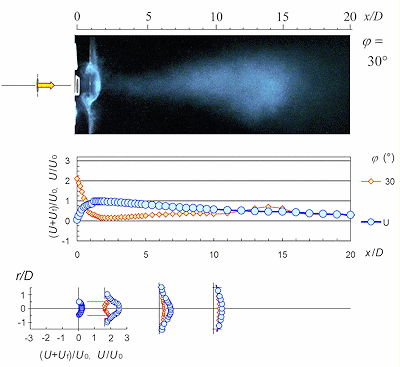
Movie 1 The phase locked visualization of the air synthetic jet synchronized with velocities during the entire actuation period (velocity profiles in the animation present hot-wire, phase averaged velocity data).
- J. Kordík, Z. Trávníček, Integral quantities of axisymmetric synthetic jets evaluated from a direct jet thrust measurement, Flow, Turbulence and Combustion 103 (3) (2019) 827–844.
- J. Kordík, Z. Trávníček, V.Timchenko, N.A. Ismail, The predominant effect of stroke length on velocity profiles at the exit of axisymmetric synthetic jet actuators, Int. J. Heat Fluid Flow 66 (2017) 197–208.
- Z. Trávníček, Z. Broučková, J. Kordík, T.Vít, Visualization of synthetic jet formation in air, J. Visual. 18 4 (2015) 595–609.
- J. Kordík, Z. Trávníček, M. Pavelka, Energetic efficiencies of synthetic and hybrid synthetic jet actuators driven by electrodynamics transducers, Exp. Thermal Fluid Sci. 69 (2015) 119–126.
- Z. Trávníček, Z. Broučková, J. Kordík, Formation criterion for axisymmetric synthetic jets at high Stokes numbers, AIAA J. 50 (9) (2012) 2012–2017.
- Z. Trávníček, V. Tesař, Annular synthetic jet used for impinging flow mass–transfer, Int. J. Heat Mass Transfer 46 (17) (2003) 3291–3297.
Optimization of the fluid jet actuators
Cooling of miniature electronic components can be realized by periodic fluid jets generated by a resonant cavity driven by an oscillating diaphragm. An optimization obtained a significant enhancement of the energetic efficiency up to 2.5 times higher values compared to available devices. The theoretical results were confirmed experimentally. The device has been designed and patented.
Fig. 1 Energetic efficiency of the jet actuator. It depends on the power input and on the ratio of the nozzle and diaphragm diameters (Dn/Dd); the function maximum indicates the optimal geometry.
Fig. 2 Results of optical measurements. Flow velocity maps are on the left, the right figure shows visualization of an impingement of the jet on the cooled cylinder.
(a) 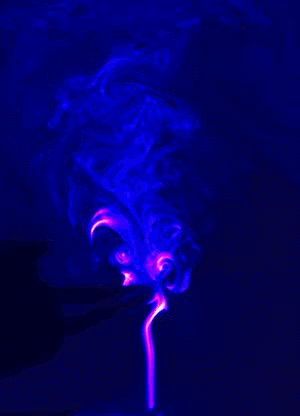
(b) 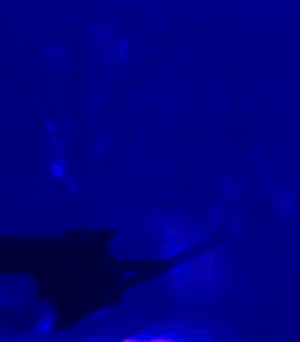
Movies 2a, b Laser-induced fluorescence (LIF) visualization of the jets impinging on the cylinder. The results indicate two different modes of flowfield, relating to different overall heat transfer rate: (a) lower Reynolds number, Re = 63 with a flow separation on the windward cylinder side, (b) moderately higher Re = 139, where flow around the leeward cylinder side occurs.
- Z. Broučková, Z. Trávníček, T. Vít, Synthetic and continuous jets impinging on a circular cylinder, Heat Transfer Eng. 40 (13–14) (2019) 1111–1125.·
- J. Kordík, Z. Trávníček, Optimal diameter of nozzles of synthetic jet actuators based on electrodynamic transducers, Exp. Thermal Fluid Sci. 86 (2017) 281–294.
- Z. Trávníček, Z. Broučková, Method and device for cooling of cylinder-shaped bodies by a cooling fluid jet, Patent No. 306506, Jan. 4, 2017 (in Czech).
Hybrid synthetic jets
The proposed hybrid synthetic jet is an advanced variant of the synthetic jet. It is generated from an actuator which combines the (common) synthetic jet actuator with a valve-less (fluidic) pump.
In contrast to standard synthetic jets, the hybrid version is intrinsically a non-zero net mass flux device. This fact enhances the produced effects.
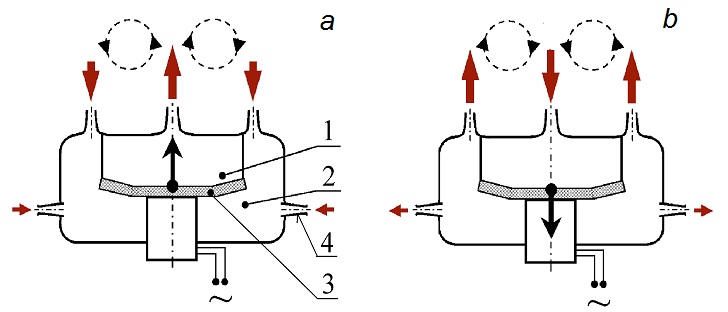
Fig. 3 Schematic representation of the double-acting actuator of the hybrid synthetic jet: 1- front chamber, 2-rear chamber, 3- oscillating diaphragm, 4- fluidic diodes; (a) displacement stroke of the front chamber (1), when chamber (2) sucks fluid; (b) suction stroke of the front chamber (1).
- Z. Broučková, Z. Trávníček, Visualization study of hybrid synthetic jets, J. Visual. 18 (4) (2015) 581–593.
- S.-S. Hsu, Y.-J. Chou, Z. Trávníček, C.-F. Lin, A.-B. Wang, R.-H. Yen, Numerical study of nozzle design for the hybrid synthetic jet actuator, Sens. Actuat. A – Phys. 232 (2015) 172–182.
- J. Kordík, Z. Trávníček, Novel fluidic diode for hybrid synthetic jet actuator, Trans. ASME, J. Fluids Eng. 135 (10) (2013) 101101-1 – 101101-7.
- A-B. Wang, Z. Trávníček, Y-H. Wang, M-C. Hsu, Double-acting device for generating of synthetic jets, US Patents No. US 7527086 B2, May 5, 2009 and No. US 7984751 B2, Jul. 26, 2011.
- Z. Trávníček, T. Vít, V. Tesař, Hybrid synthetic jet as the non-zero-net-mass-flux jet, Phys. Fluids 18 (8) (2006) 081701-1–081701-4.
- Z. Trávníček, V. Tesař, A.-B. Wang, Enhancement of synthetic jets by means of an integrated valve-less pump, Part II: Numerical and experimental studies. Sens. Actuat. A – Phys. 125 (2005) 50-58.
- Z. Trávníček, A. Fedorchenko, A.-B. Wang, Enhancement of synthetic jets by means of an integrated valve-less pump, Part I: Design of the actuator, Sens. Actuat. A – Phys. 120 (2005) 232–240.
Synthetic jets generated by biomimetic actuators
Following biomimetic principles, the synthetic jet actuator can incorporate a nozzle in which the cross-sectional area periodically oscillates during the driven cycle. A phase shift between the driven diaphragm and nozzle cycles can be optimized to obtain enhanced heat/mass transfer characteristics.
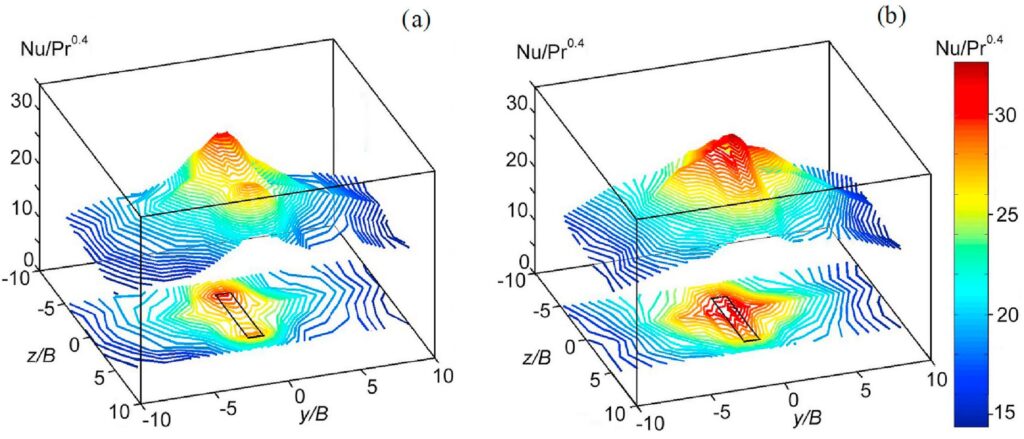
Fig. 4 Local heat transfer distributions onto impingement wall for various phase shifts between the diaphragm and nozzle cycles: (a) 0°, (b) 270°.
- Z. Trávníček, Z. Antošová, Impingement heat transfer to the synthetic jet issuing from a nozzle with an oscillating cross section, Int. J. Therm. Sci. 153 (2020) 106349.
- Z. Trávníček, Z. Broučková, Characterization of impingement heat/mass transfer to the synthetic jet generated by a biomimetics actuator, Trans. ASME, J. Heat Transfer 141 (4) (2019) 042203-1–042203-9.
- Z. Trávníček, Z. Broučková, A synthetic jet issuing from a bio-inspired actuator with an oscillating nozzle lip, Trans. ASME, J. Fluids Eng. 140 (10) (2018) 101104-1 – 101104-5.
Local heat/mass transfer coefficients
Distribution of the local heat/mass transfer coefficients in air (Nusselt /Sherwood numbers), can be evaluated using the naphthalene sublimation technique and considering the heat/mass transfer analogy.
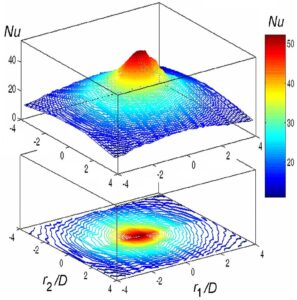
Fig. 5 Typical distribution of the Nusselt number on the wall exposed to the impinging jet, namely the axisymmetric synthetic jet.
- Trávníček, T. Vít, Impingement heat/mass transfer to hybrid synthetic jets and other reversible pulsating jets. Int. J. Heat Mass Transfer 85 (2015) 473–487.
- Z.Trávníček, K. Peszyński, J. Hošek, S. Wawrzyniak, Aerodynamic and mass transfer characteristics of an annular bistable impinging jet with a fluidic flip–flop control. Int. J. Heat Mass Transfer 46 (7) (2003) 1265–1278.
Non-isothermal wake flow
The phenomenon of vortex shedding from a bluff body is important for the theoretical study of hydrodynamic instabilities as well as for its practical engineering aspect. It is considered to be a source of flow-induced vibrations, noise, and even a structure collapse. The results revealed the thermal effects in air: Firstly, cylinder heating stabilizes the wake flow in air, i.e., the vortex shedding frequency decreases and even the vortex shedding can be completely suppressed. Consistently, cylinder cooling destabilizes the wake flow and the vortex shedding frequency increases as the cylinder temperature decreases and even the laminar steady regime can be changed into the vortex shedding regime. The effect was quantified and generalized by means of the effective temperature concept.
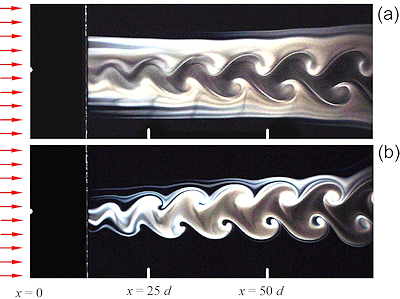
Fig. 6 Laminar vortex shedding behind a cooled circular cylinder in air. The flow temperature is T∞ = 144.5oC and the Reynolds number is Re∞ = 61; (a) isothermal case and (b) cooling of the cylinder to TW = 17.3oC. The results demonstrate that cooling causes an increase of the vortex shedding frequency.
- Z. Trávníček, A.-B. Wang, W.-Y. Tu, Laminar vortex shedding behind a cooled circular cylinder, Exp. Fluids 55 (2) (2014), 1679-1–1679-12.
- M.-H. Wu, Z. Trávníček, A.-B. Wang, The onset of oblique vortex shedding behind a heated circular cylinder in laminar wake regime, Phys. Fluids 24 (2012) 011701-1–011701-7.
- A.-B. Wang, Z. Trávníček, K.-C. Chia, On the relationship of effective Reynolds number and Strouhal number for the laminar vortex shedding of a heated circular cylinder, Phys. Fluids 12 (6) 2000 1401–1410.
Hysteresis and bistability in impinging jets
Under specific conditions, the impinging jets can demonstrate bistable and hysteretic behaviour in two-dimensional and axisymmetric geometries. It means that the boundary conditions alone cannot determine the flowfield uniquely, because the flow pattern depends on flowfield history.
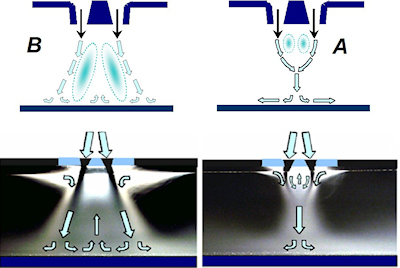
Fig. 7 Flowfield assumption (top figures) and flow visualization (bottom figures) in a two-dimensional case.
- Z. Trávníček, V. Tesař, Hysteresis in annular impinging jets, Exp. Thermal Fluid Sci. 44 (2013) 565–570.
- Z. Trávníček, F. Maršík, Visualization and mass transfer with a bistable two-slot impinging jet, J. Visual. 6 (4) (2003) 417–421.
- Z. Trávníček, F. Křížek, Impinging jet and combined slot nozzle (Impaktströmung und die Zusammengesetzte Schlitzdüse), Heat and Mass Transfer 35 (5) (1999) 351–356 (in German).
Active control of flow/thermal fields
An active control of flow/thermal fields is a multi-disciplinary science, with the technology focused on the manipulation of natural flow/thermal states into intended and profitable ones. Pulsating fluid jet flows are one of several useful tools for the active control.
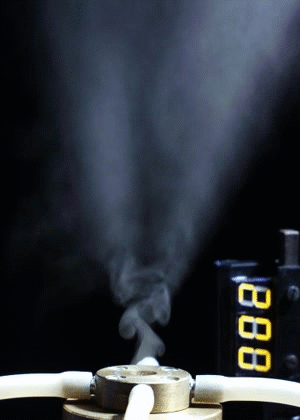
Movie 3 Visualization of the axisymmetric jet in the bifurcated mode at the actuating frequency of 82 Hz.
- Z. Broučková, Z. Trávníček, Intermittent round jet controlled by lateral pulse-modulated synthetic jets, J. Visual. 22 (3) (2019) 459–476.
- Z. Trávníček, V. Tesař, Z. Broučková, K. Peszyński, Annular impinging jet controlled by radial synthetic jets, Heat Transfer Engineering 35 (16-17) (2014) 1450–1461.
- Z. Trávníček, L. Němcová, J. Kordík, V. Tesař, V. Kopecký, Axisymmetric impinging jet excited by a synthetic jet system, Int. J. Heat Mass Transfer 55 (2012) (4) 1279–1290.
Coffee sound and its visualization
This research features two levels of significance. The first level is science popularization and a demonstration of the fact that experimental fluid mechanics and thermodynamics are not enclosed in sophisticated laboratories, but their manifestation is evident in a daily life. A "kitchen experiment" during preparation of coffee is demonstrated. The tone is generated by a standing wave in the liquid, similarly as tones in musical instruments (flute, organ) are generated in air. While the tone in air is constant at a given temperature, the tone of coffee slowly rises in pitch, because the speed of sound increases as the bubbles disappear.
The second level of this study is aimed at specialists. The relatively simple experiment can be interpreted and quantified, revealing novel findings. Sound record has been analysed using time-frequency signal processing. The described sound effect can find its application in laboratories and industry, e.g. for a contactless measurement of composition of a two-phase mixture. A clearly distinguishable 6.3 octaves decrease of the tone pitch was found at vacuum degasification of water, as is shown in the spectrogram.
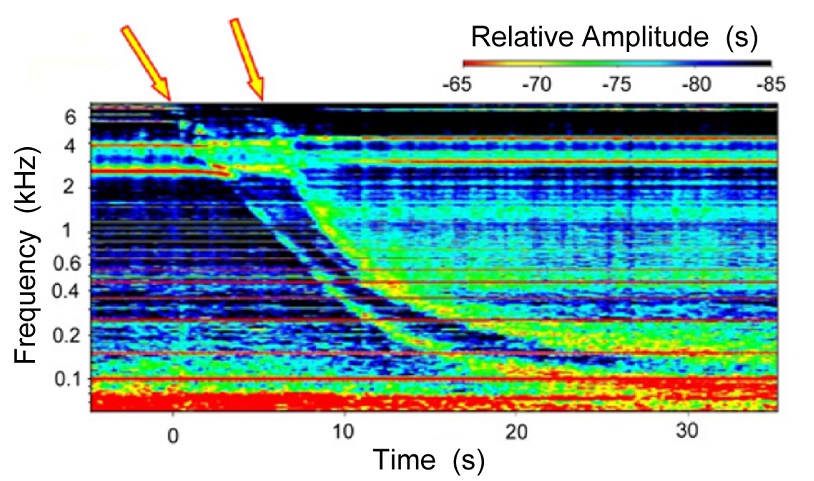
Fig. 8 Spectrogram of the sound effect related to the vacuum degasification of water.
- Z. Broučková, Z. Trávníček, P. Šafařík, Bubble dynamics in drinks, EPJ Web of Conferences, 67 (2014) Article No. 02011.
- Z. Trávníček, A.I. Fedorchenko, M. Pavelka, J. Hrubý, Visualization of the hot chocolate sound effect by spectrograms, J. Sound Vibr. 331 (2012) 5387–5392.
System for measurement of the local mass transfer on the wall using the naphthalene sublimation technique in air. Distribution of the local mass transfer coefficient, expressed as the Sherwood number, can be evaluated on the surface of the size of 100 x 450mm. Using the heat/mass transfer analogy, the local heat transfer coefficient, expressed as the Nusselt number, can be obtained.
System for measurement of the local heat flux (RdF Micro-Foil sensors, size 1.5 x 3 mm). Distribution of the local heat transfer coefficient, expressed as the Nusselt number, can be evaluated.
System for optical measurements of velocity and temperature fields in water and air: planar Particle Image Velocimetry (PIV) and Laser-Induced Fluorescence (LIF), (DANTEC).
Mass flow controller for gases (F-201A, Bronkhorst); range 0.6–30 ln/min.
Hot-wire measurement in air and water (single probe, DANTEC anemometer).
System for measurement of acoustic pulsations, equipped with 40BP 1/4" sensor externally polarized pressure microphone (ranges 10 Hz – 20 kHz, 34 dB (A) – 193 dB, sensitivity 0.4mV/Pa).
Electronic thermometers (Omega, Ahlborn) and fine manometers (Greisinger).

